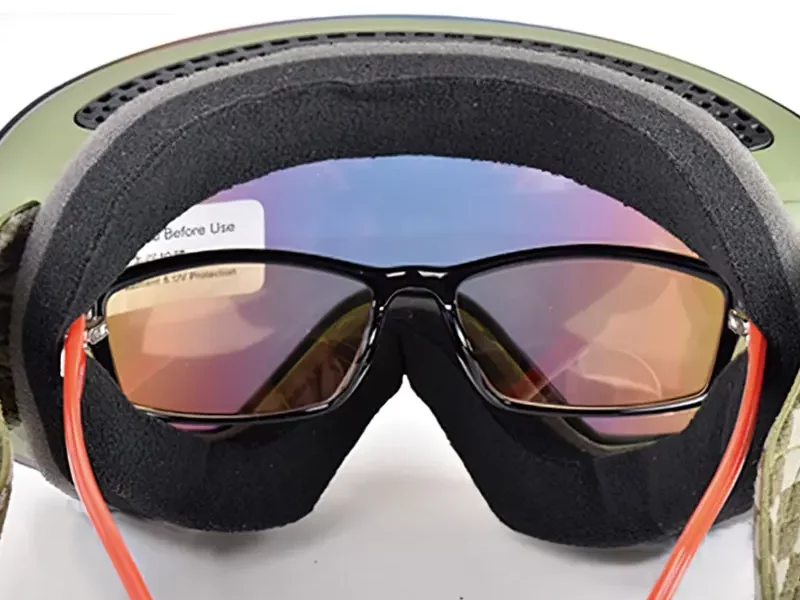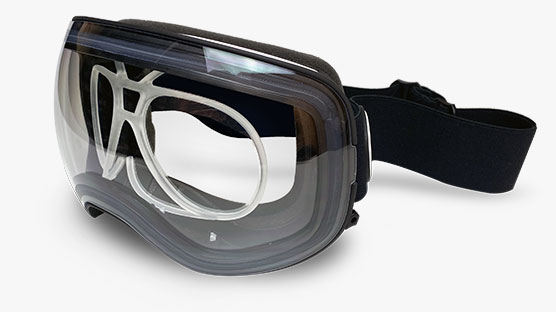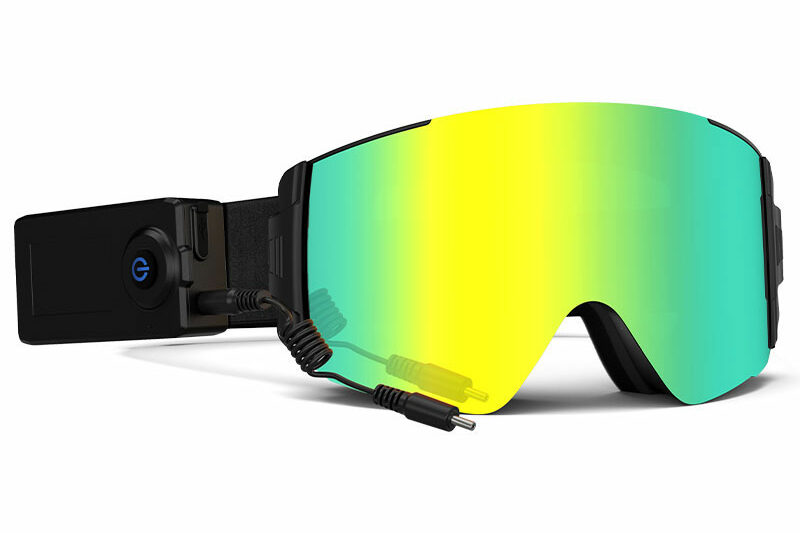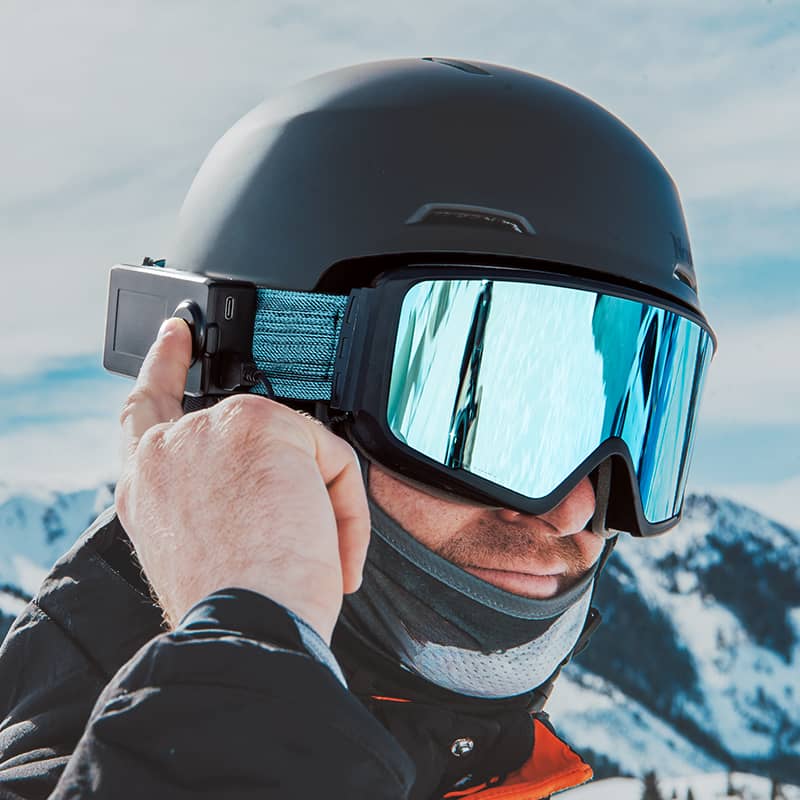Indossare la maschera da sci con gli occhiali da vista può rappresentare una sfida per molti, ma niente paura! Con la giusta guida e i giusti consigli, è assolutamente fattibile. Che si tratti di trovare la maschera perfetta occhiali da sci Che si tratti di occhiali da vista o di addentrarsi nel mondo delle maschere da sci e degli inserti da vista, abbiamo quello che fa per te. Avere una visione nitida sulle piste è essenziale per un'esperienza sciistica piacevole, soprattutto per chi si affida agli occhiali. Immergiamoci quindi nel mondo degli occhiali da sci ed esploriamo le migliori opzioni per migliorare la tua avventura sugli sci indossando gli occhiali.
Occhiali da sci OTG (sopra gli occhiali)

Quando si scia con gli occhiali, trovare la maschera da sci giusta è fondamentale per un'esperienza di sci confortevole e chiara. Un'opzione popolare per chi porta gli occhiali sono le maschere da sci OTG (Over the Glasses).
Gli occhiali da sci OTG sono appositamente progettati per adattarsi comodamente sopra gli occhiali da vista. Questi occhiali presentano una montatura più ampia e lenti più profonde, lasciando abbastanza spazio per sistemare gli occhiali senza causare fastidio o pressione sul viso di chi li indossa.
Vantaggi degli occhiali da sci OTG
Il vantaggio principale delle maschere da sci OTG è che eliminano il fastidio di indossare due montature contemporaneamente. Per chi fa affidamento su occhiali da vista, queste maschere da sci offrono una visione chiara e libera, garantendo che la vista rimanga libera durante la discesa.
Svantaggi degli occhiali da sci OTG
Sebbene le maschere da sci OTG offrano una soluzione pratica per chi indossa gli occhiali, alcuni utenti potrebbero trovarle più ingombranti rispetto alle maschere da sci tradizionali. Le dimensioni maggiori possono influire sull'estetica e sulla vestibilità generale, causando potenzialmente piccoli inconvenienti per alcuni.
Inserti per occhiali da sci

Gli inserti per occhiali da sci con lenti graduate offrono una soluzione pratica per chi necessita di una correzione della vista mentre scia indossando gli occhiali. Questi inserti su misura si adattano perfettamente all'interno degli occhiali da sci, fornendo la correzione visiva necessaria senza compromettere il comfort o la nitidezza visiva.
Vantaggi dei foglietti illustrativi
Uno dei principali vantaggi dell'utilizzo di foglietti illustrativi è il comodità e sicurezza che offrono. Chi porta gli occhiali può sciare comodamente con una vista corretta, senza dover indossare i propri occhiali normali sotto la maschera.
Inoltre, gli inserti per lenti graduate possono essere facilmente intercambiati tra diversi paia di occhiali da sci, offrendo flessibilità e versatilità agli utenti che possiedono più paia di occhiali.
Svantaggi dei foglietti illustrativi
Sebbene gli inserti correttivi offrano una soluzione efficace per la correzione della vista durante lo sci, alcuni utenti potrebbero trovarli leggermente ingombranti o limitanti. Lo strato aggiuntivo all'interno della maschera può influire sulla visione periferica o contribuire a una calzata più aderente, il che potrebbe potenzialmente compromettere il comfort generale durante periodi di utilizzo prolungati.
Occhiali da sci con prescrizione medica

Le maschere da sci con prescrizione medica sono una vera svolta per chi ha problemi di vista e ama sciare. Queste maschere da sci specializzate sono dotate di lenti correttive integrate, personalizzate in base alla prescrizione dell'utilizzatore, offrendo una soluzione perfetta per una visione nitida durante lo sci.
Vantaggi degli occhiali da sci graduati
La natura personalizzabile delle maschere da sci con lenti graduate le rende la scelta ideale per chi indossa occhiali e cerca soluzioni su misura. Che si tratti di regolare la tonalità delle lenti in base alle diverse condizioni di luce o di integrare rivestimenti specifici per prevenire l'appannamento, queste maschere offrono versatilità e comfort.
Inoltre, gli occhiali da sci con prescrizione forniscono una vestibilità comoda e aderente Progettati specificamente per chi indossa occhiali, garantiscono un'esperienza visiva sicura e stabile, senza compromettere lo stile o le prestazioni visive.
Svantaggi degli occhiali da sci con prescrizione medica
Sebbene gli occhiali da sci con prescrizione medica offrano numerosi vantaggi, alcuni utenti potrebbero trovarli relativamente costoso rispetto ad altre alternativeLe caratteristiche di design specializzato e personalizzazione possono contribuire ad aumentare il prezzo, il che potrebbe essere un fattore da tenere in considerazione per gli sciatori attenti al budget e in cerca di soluzioni per la correzione della vista.
Indossare lenti a contatto per lo sci e lo snowboard

Vantaggi delle lenti a contatto
Quando si tratta di praticare sport invernali come lo sci e lo snowboard, le lenti a contatto offrono una valida alternativa per chi preferisce non indossare gli occhiali sotto la maschera da sci. L'uso delle lenti a contatto elimina l'inconveniente e il disagio associati all'uso degli occhiali Durante queste attività. Inoltre, le lenti a contatto riducono il rischio di appannamento, che si verifica comunemente quando si indossano gli occhiali sotto la maschera da sci, garantendo una visione chiara e libera durante la discesa.
Svantaggi delle lenti a contatto
Nonostante i vantaggi, è importante riconoscere che le lenti a contatto potrebbero non essere adatte a tutti. Alcune persone potrebbero provare fastidio o secchezza quando indossano le lenti a contatto in ambienti freddi e ventosi, come le stazioni sciistiche. Inoltre, c'è il rischio di perdere una lente durante cadute o altre attività ad alto impatto, il che potrebbe compromettere l'esperienza sciistica.
Considerazioni per chi porta le lenti a contatto
Per chi sta pensando di indossare lenti a contatto durante lo sci o lo snowboard, un'adeguata cura degli occhi e la manutenzione delle lenti sono fondamentali. È essenziale assicurarsi che le lenti siano pulite e prive di detriti per prevenire qualsiasi fastidio o irritazione durante le attività all'aperto. Optare per lenti a contatto giornaliere usa e getta può ridurre al minimo il rischio di accumulo di detriti e offrire maggiore praticità, eliminando la necessità di pulirle e conservarle dopo l'uso.
Qual è la soluzione migliore per sciare se si indossano gli occhiali?

Nella scelta della soluzione ottica migliore per sciare con gli occhiali, è fondamentale confrontare le diverse opzioni disponibili e valutarne i rispettivi vantaggi e svantaggi. Valutando queste soluzioni, è possibile prendere una decisione consapevole, in linea con le proprie esigenze e preferenze individuali.
- Occhiali da sci OTG: Le maschere da sci OTG offrono una soluzione pratica per chi preferisce sciare con i propri occhiali da vista. Pur offrendo una visione chiara e senza ostacoli, alcuni utenti potrebbero trovarle più ingombranti rispetto alle maschere da sci standard.
- Foglietti illustrativi: Gli inserti per lenti graduate all'interno delle maschere da sci offrono un modo pratico per sciare con una vista corretta senza indossare occhiali tradizionali. Tuttavia, alcuni potrebbero trovarli leggermente ingombranti o limitanti durante l'uso prolungato.
- Occhiali da sci con prescrizione medica: Questi occhiali speciali sono dotati di lenti correttive integrate, personalizzate in base alla prescrizione dell'utilizzatore. Offrono una vestibilità comoda e personalizzata, ma possono essere relativamente costosi rispetto ad altre alternative.
- Lenti a contatto: Le lenti a contatto offrono un'alternativa all'uso degli occhiali da vista sotto la maschera da sci, eliminando il rischio di appannamento e il fastidio associati all'uso di due lenti. Tuttavia, alcuni individui potrebbero avvertire secchezza o fastidio in ambienti freddi e ventosi.
Come evitare che gli occhiali si appannino sotto la maschera da sci
Tecniche anti-appannamento
Per godersi un'esperienza di sci limpida e senza appannamento indossando gli occhiali sotto la maschera da sci, esistono diverse tecniche e prodotti antiappannamento che possono migliorare significativamente la visibilità.
- Scopri i rivestimenti e le salviette antiappannamento: Molte aziende offrono rivestimenti e salviette antiappannamento appositamente progettati per prevenire l'appannamento delle maschere da sci. Questi prodotti creano una pellicola sottile e trasparente sulla superficie interna della maschera, riducendo l'accumulo di umidità che causa l'appannamento.
- Regolazioni di ventilazione e vestibilità adeguate: Garantire un'adeguata ventilazione all'interno degli occhiali da sci è essenziale per ridurre al minimo i problemi di appannamento. Cerca occhiali antiappannamento Con sistemi di ventilazione ben progettati che favoriscono il flusso d'aria impedendo l'ingresso di neve o detriti. Inoltre, apportare modifiche alla vestibilità per ottenere una tenuta aderente ma traspirante può contribuire a mantenere una visione chiara riducendo la condensa.
Suggerimenti per una visione senza appannamento
Mantenere una visione chiara grazie agli occhiali antiappannamento sotto la maschera da sci è fondamentale per un'esperienza sugli sci piacevole. Ecco alcuni consigli per prevenire l'appannamento e garantire una visibilità ottimale:
- Preriscaldare gli occhiali e la maschera: Prima di scendere sulle piste, preriscaldare gli occhiali da sci e la maschera può aiutare a prevenire la formazione di condensa e appannamento. Puoi farlo posizionandoli in un ambiente interno caldo o riscaldandoli delicatamente con il calore corporeo prima di avventurarti in temperature più fredde.
- Assicurare una vestibilità aderente e sicura: Una corretta calzata della maschera da sci è fondamentale per favorire la circolazione dell'aria e ridurre l'appannamento. Regolate i lacci per ottenere una calzata sicura ma confortevole, che consenta un adeguato flusso d'aria intorno agli occhiali. Una maschera da sci ben calzante riduce al minimo la ritenzione di umidità, evitando così che l'appannamento ostruisca la vista.
Grazie a queste tecniche antiappannamento e ai suggerimenti per mantenere una visione nitida, gli sciatori con gli occhiali potranno godere di una vista ininterrotta degli spettacolari paesaggi invernali, sfrecciando sulle piste con sicurezza.
Conclusione
In conclusione, è fondamentale per chi indossa occhiali trovare la soluzione giusta per lo sci, per garantire un'esperienza confortevole e nitida sulle piste. Che si scelgano maschere da sci OTG, inserti correttivi, maschere da sci graduate o lenti a contatto, sono disponibili diverse opzioni per soddisfare le proprie esigenze. Valutando i vantaggi e gli svantaggi di ciascuna opzione, è possibile prendere una decisione consapevole, in linea con le proprie preferenze e le proprie esigenze di correzione della vista. Si consiglia vivamente di consultare un optometrista professionista.


25年-香港展邀请函(横屏-英文版)-1024x358.jpg)

